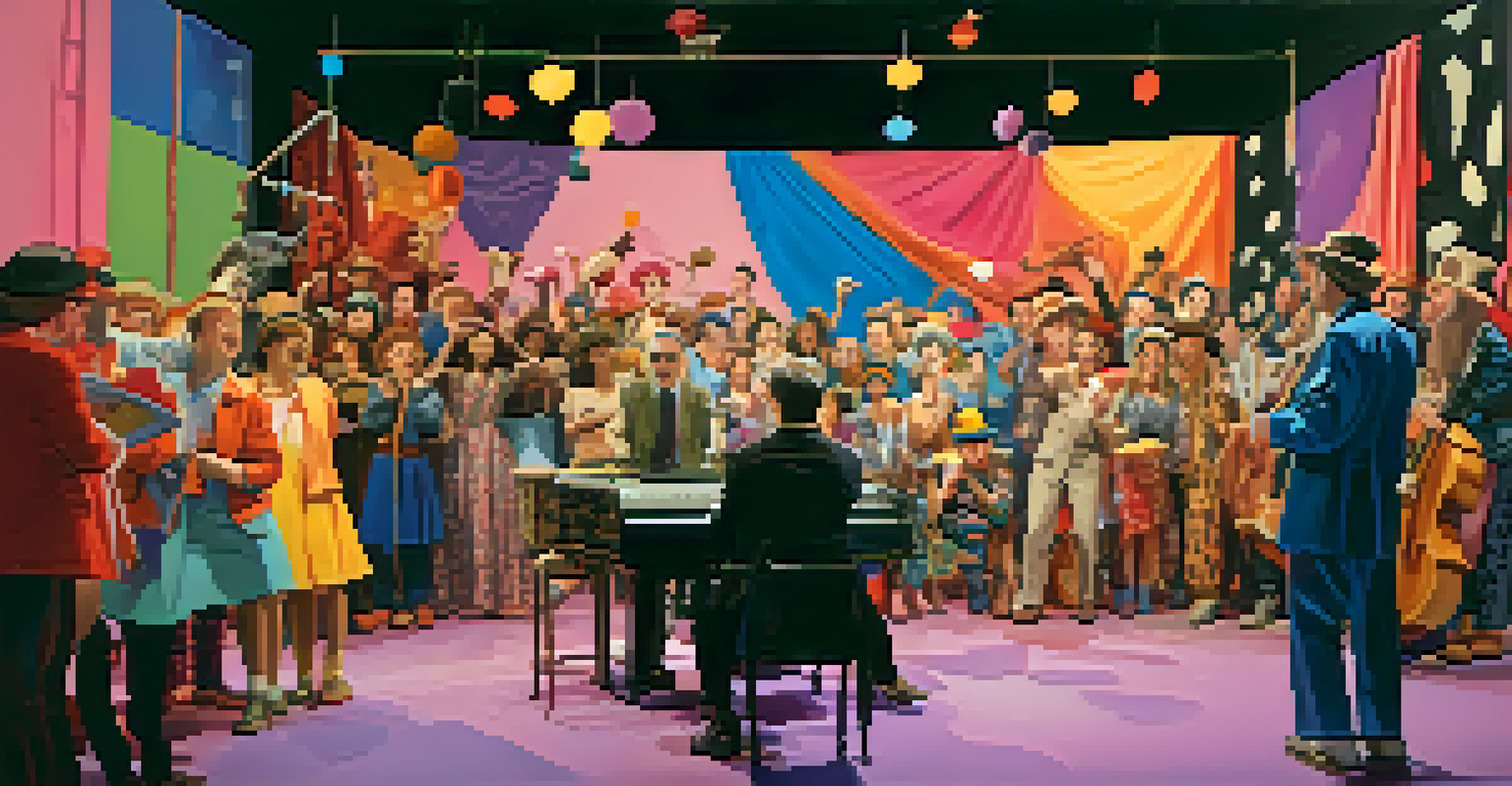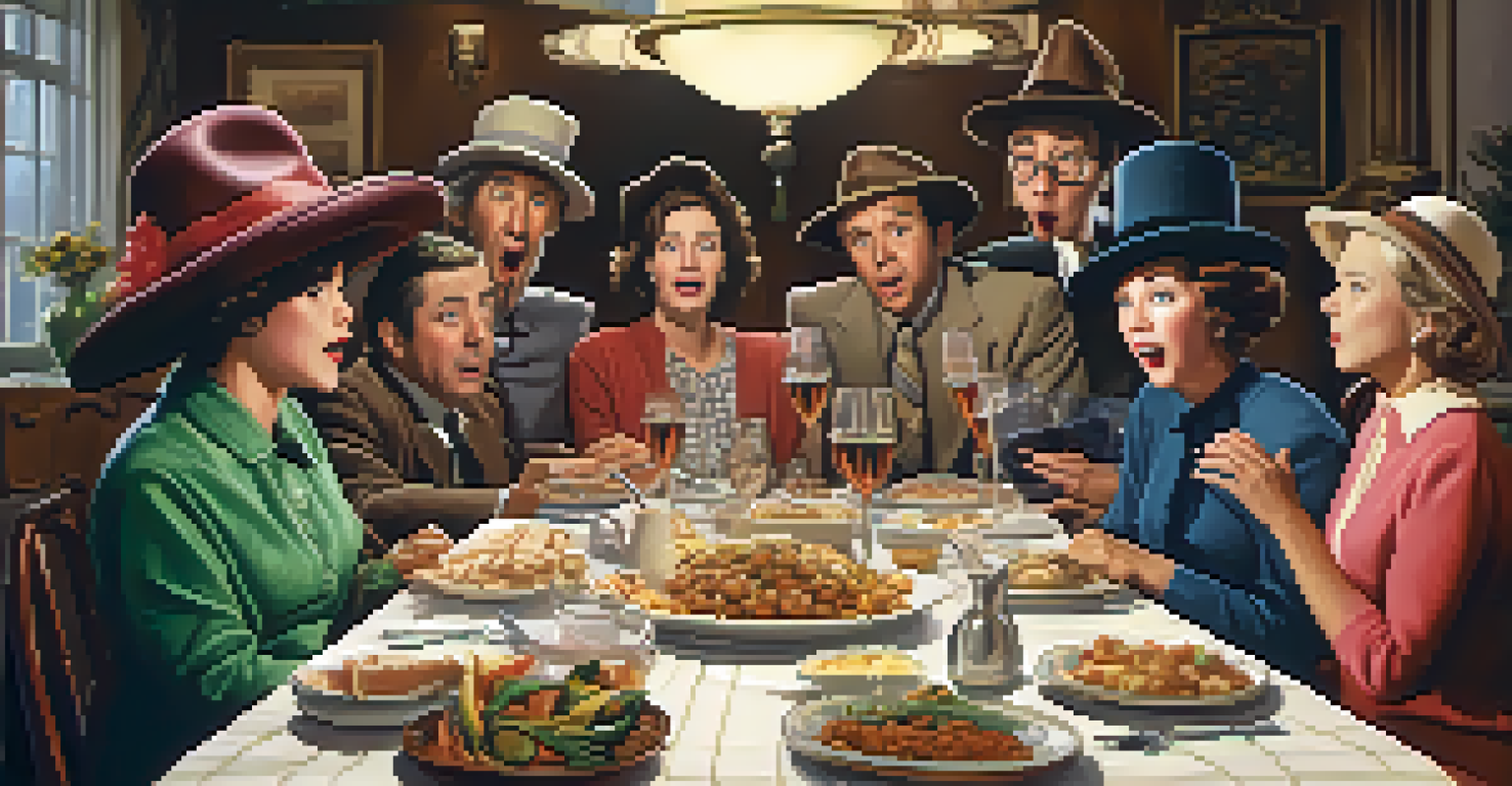Understanding Absurdism: Humor in Contemporary Art Trends

What is Absurdism and Its Roots in Philosophy?
Absurdism is a philosophical concept that explores the conflict between humans' desire to find inherent meaning in life and the universe's indifferent silence. It emerged from the works of thinkers like Albert Camus, who suggested that life is inherently chaotic and illogical. This can lead to feelings of disconnection and absurdity, which many artists reflect in their work.
The absurd is the essential concept and the first truth.
In the realm of art, absurdism often manifests as a humorous response to life's unpredictability. Artists use humor as a coping mechanism, channeling the absurdity of existence into their creations. This approach not only invites laughter but also encourages viewers to grapple with deeper existential questions.
By presenting the absurd in a light-hearted manner, artists can engage audiences in a unique way. They challenge traditional perceptions of life and art, prompting us to find meaning in the chaos. This blend of humor and philosophy is what makes absurdism particularly relevant in contemporary art.
The Role of Humor in Absurdist Art
Humor serves as a vital tool in absurdist art, acting as a bridge between the viewer and the artist's intentions. By incorporating comedic elements, artists disarm their audience, making them more receptive to complex themes. This playful approach allows for deeper reflection on serious subjects, such as identity, existence, and societal norms.

For example, consider the works of contemporary artist David Shrigley, whose quirky and often childlike drawings evoke laughter while addressing profound issues. His art exemplifies how humor can highlight the absurdity of life, making heavy ideas more accessible. This combination of levity and depth encourages viewers to engage with the artwork on multiple levels.
Absurdism Blends Humor and Depth
Absurdism uses humor as a tool to engage audiences, prompting deeper reflections on serious themes like existence and identity.
Furthermore, humor in absurdism often reveals the absurdity of everyday situations, inviting us to laugh at our own experiences. This cathartic release not only fosters a sense of connection among viewers but also reflects the shared human condition. In this way, humor becomes a vehicle for exploring life's complexities.
Contemporary Artists Embracing Absurdism
Many contemporary artists have adopted absurdism as a core theme in their work, showcasing its relevance in today's society. Artists like Yayoi Kusama and Jeff Koons utilize humor and absurd elements to challenge conventional aesthetics. Their art encourages viewers to question reality and consider alternative perspectives.
Life can be understood only in retrospect; but it must be lived forwards.
Kusama's immersive installations, filled with polka dots and surreal imagery, create a whimsical environment that evokes both joy and contemplation. Meanwhile, Koons' larger-than-life sculptures playfully engage with consumer culture and art commodification. Both artists illustrate how absurdism can be a powerful commentary on modern life.
Moreover, these artists often employ irony and satire to critique societal norms and expectations. This approach not only entertains but also provokes thought, making their work resonate with diverse audiences. The blending of humor and absurdity in contemporary art continues to inspire new generations of creators.
Absurdism in Performance Art
Performance art is another arena where absurdism thrives, often blurring the lines between reality and fiction. Artists like Marina Abramović and the late Andy Kaufman have utilized humor to confront audiences with the absurdity of existence. Their performances challenge viewers to question their perceptions and expectations.
For instance, Abramović's work frequently involves elements of endurance and vulnerability, pushing boundaries while evoking laughter and discomfort. Similarly, Kaufman's unpredictable routines challenged traditional comedic norms, often leaving audiences both perplexed and amused. This interplay of humor and absurdity invites viewers to explore deeper truths.
Contemporary Artists Embrace Absurdism
Modern artists like Yayoi Kusama and Jeff Koons leverage absurdity in their work to challenge societal norms and provoke thought.
The ephemeral nature of performance art enhances its absurdist qualities, as each experience is unique and fleeting. This transience mirrors life's unpredictability, reinforcing the idea that meaning is often elusive. Through performance, artists can engage audiences in a dynamic conversation about the absurd aspects of life.
Absurdism's Influence on Film and Literature
Absurdism's impact extends beyond the visual arts into film and literature, where humor plays a crucial role in exploring existential themes. Filmmakers like Wes Anderson and writers like Franz Kafka use absurd scenarios to highlight the quirks of human nature. Their works often blend humor with a sense of melancholy, inviting audiences to ponder the absurdity of life.
Anderson's films, characterized by their whimsical aesthetics and unconventional narratives, often evoke laughter while addressing serious issues like family dynamics and identity. Similarly, Kafka's stories present absurd situations that provoke deep reflections on existence. Both creators demonstrate how absurdism can enhance storytelling by merging humor with philosophical inquiry.
This cross-pollination of absurdist themes across different mediums enriches our understanding of the human experience. By engaging with these works, audiences are encouraged to confront their own absurdities and find humor in life's unpredictability. In doing so, absurdism becomes a shared experience that resonates with many.
The Future of Absurdism in Art
As we move further into the 21st century, the relevance of absurdism in art continues to grow. With the rise of digital media and social platforms, artists are finding new ways to express absurdist themes. This evolution opens up fresh avenues for humor and creativity, ensuring that the absurd remains a vital part of contemporary discourse.
The internet has become a fertile ground for absurdist expression, with memes and viral content reflecting the chaotic nature of modern life. These digital formats often encapsulate absurdity in a concise and humorous way, making complex ideas accessible to a wider audience. As absurdism permeates popular culture, it invites more people to engage with its themes.
Absurdism's Reach in Media
The influence of absurdism extends into film and literature, where creators like Wes Anderson and Franz Kafka explore existential themes through humor.
Looking ahead, the fusion of absurdism with emerging technologies promises to reshape the art landscape. Virtual reality, augmented reality, and interactive installations may provide new ways to explore the absurd, creating immersive experiences that challenge our perceptions. The future of absurdism in art is bright and full of potential.
Conclusion: Embracing Absurdity in Art and Life
In conclusion, absurdism serves as a lens through which we can explore the complexities of life with humor and creativity. By embracing the absurd, artists invite us to confront our existential dilemmas while finding joy in the chaos. This approach not only enriches the art world but also reflects the human experience in a relatable way.
As we navigate an increasingly unpredictable world, the lessons of absurdism resonate more than ever. Humor allows us to connect with one another and find solace in shared experiences. By appreciating the absurd, we can cultivate resilience and a sense of community in our lives.

Ultimately, absurdism encourages us to embrace uncertainty and seek meaning in the seemingly meaningless. Whether through art, performance, or literature, we can find laughter and insight amid life's absurdities, reminding us that even in chaos, we are not alone.